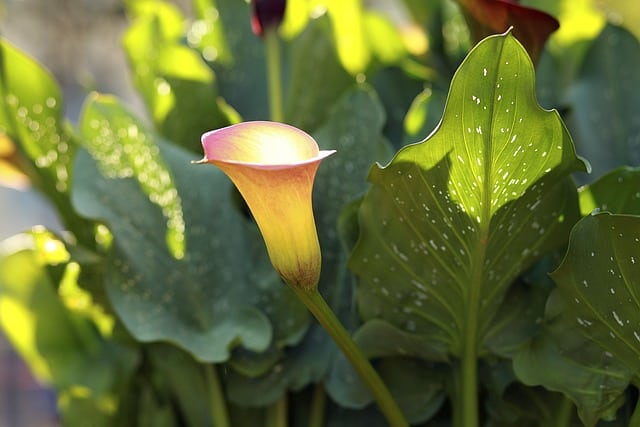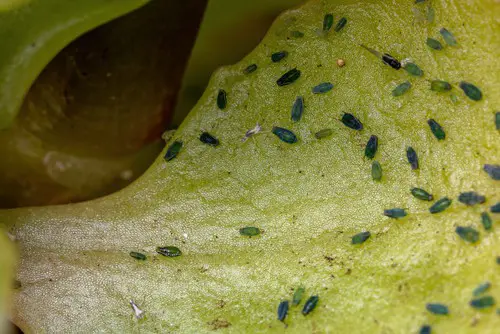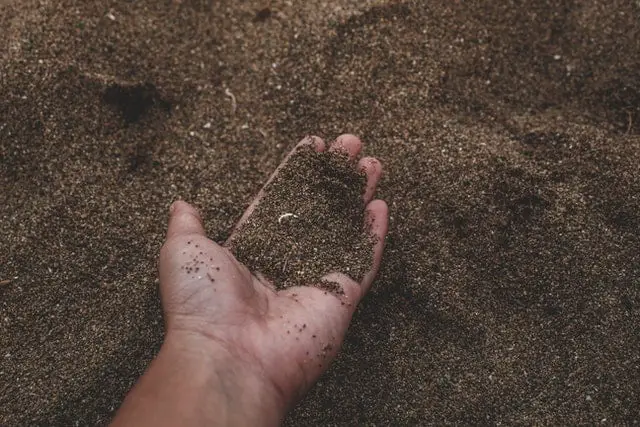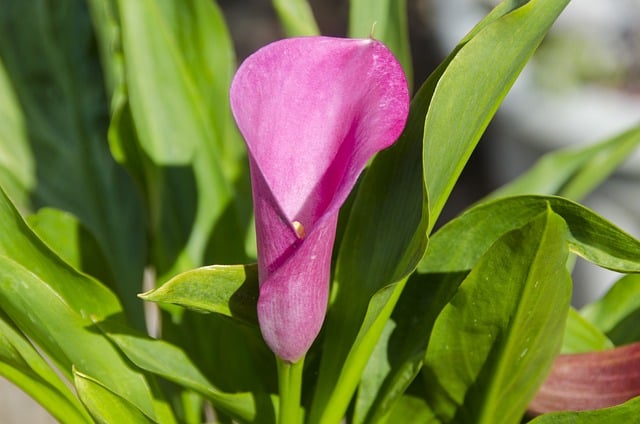Calla lilies are a popular choice for gardeners and florists alike, thanks to their elegant, trumpet-shaped blooms and lush, green foliage. However, one common problem that many people face when growing calla lilies is yellowing leaves.
While this issue may seem concerning, it’s important to understand that it is often a sign of an underlying problem that can be addressed with the right care and attention.
There are several potential causes of calla lilies turning yellow, including overwatering, underwatering, nutrient deficiencies, pests and diseases, and more. Understanding these causes is key to addressing the issue and restoring your calla lilies to their full health and beauty.
By taking a proactive approach to care and addressing any problems as soon as they arise, you can help ensure that your calla lilies thrive year after year.
Key Takeaways
- Yellowing calla lily leaves can be a sign of an underlying problem, such as overwatering, nutrient deficiencies, or pests and diseases.
- Understanding the causes of yellowing leaves is key to addressing the issue and restoring your calla lilies to full health and beauty.
- By taking a proactive approach to care and addressing any problems as soon as they arise, you can help ensure that your calla lilies thrive year after year.
Other top posts you shouldn’t miss on:
Understanding Calla Lily

Calla lilies are a popular ornamental plant that belongs to the Araceae family. Native to South Africa, these plants are known for their beautiful flowers and lush green foliage. Calla lilies are available in different colors, including white, yellow, pink, and red.
The plant is also known by other names, including arum lily, trumpet lily, and pig lily.
Calla lilies grow from rhizomes, which are underground stems that store nutrients and water. The plant can grow up to three feet tall and requires well-draining soil and partial shade. Calla lilies are hardy in USDA zones 8 to 10 and can be grown as perennials in these regions.
Calla lilies are easy to care for and can be grown both indoors and outdoors. They require regular watering and fertilization to thrive. However, overwatering can cause the leaves to turn yellow, and the plant can become susceptible to root rot.
Calla Lilies Turning Yellow
Yellowing leaves on calla lilies can be caused by a variety of factors, including overwatering, underwatering, inadequate light, pest infestation, disease, nutrient deficiencies, and age.
Overwatering can lead to waterlogging in the soil, which can prevent the roots from absorbing nutrients and oxygen. This can cause the leaves to turn yellow and eventually die. Similarly, underwatering can cause the leaves to wilt and turn yellow due to lack of moisture.
Light is also an important factor to consider when it comes to calla lilies. While they prefer full sun to partial shade, excessive sunlight can cause the leaves to scorch and turn yellow. On the other hand, inadequate light can cause the plant to become weak and spindly, with yellowing leaves.
Pest infestation and disease can also cause yellowing leaves on calla lilies. Common pests include spider mites, aphids, and thrips, while common diseases include root rot, bacterial soft rot, powdery mildew, and botrytis.
Nutrient deficiencies, particularly nitrogen, iron, zinc, and magnesium, can also cause yellowing leaves on calla lilies. This condition is known as chlorosis and can be caused by a lack of proper nutrition in the soil. Soil pH and drainage can also play a role in nutrient deficiencies and yellowing leaves.
Finally, age can also cause yellowing leaves on calla lilies. As the plant matures, the lower leaves may naturally turn yellow and die off. It is important to monitor the overall health of the plant and remove any dead or dying leaves to promote new growth.
1. Effects of Overwatering and Underwatering

Overwatering and underwatering are two common issues that can cause calla lily leaves to turn yellow. Both of these problems can lead to root damage, which can affect the overall health of the plant.
When a calla lily is overwatered, it can lead to waterlogging, which means that the soil is saturated with water and there is no room for air. This can cause the roots to suffocate and rot, which can lead to yellowing leaves. Excessive moisture can also attract pests and diseases, which can further damage the plant.
On the other hand, underwatering can cause the soil to become too dry, which can also lead to root damage. When the roots are not getting enough water, they can become dehydrated and unable to absorb nutrients from the soil. This can also cause the leaves to turn yellow and eventually wilt.
Transplant shock is another issue that can cause yellowing leaves in calla lilies. When a plant is moved from one location to another, it can experience stress and shock.
This can cause the plant to lose some of its leaves or turn yellow. It is important to water the plant properly and provide it with the right amount of nutrients to help it recover from transplant shock.
2. Importance of Light and Temperature
Calla lilies require the right amount of light and temperature to grow properly. Light is essential for photosynthesis, which is the process that produces energy for the plant.
Insufficient light can lead to yellowing of the leaves, stunted growth, and poor flower production. On the other hand, too much light can cause the leaves to burn, leading to brown spots and crispy edges.
Calla lilies prefer bright, indirect light, and partial shade. They can tolerate full sun but only in cooler climates or during the winter months. During summer, it is best to provide some shade to prevent the leaves from burning. In general, calla lilies need at least six hours of sunlight each day to thrive.
Temperature is another important factor to consider when growing calla lilies. These plants prefer temperatures between 60°F to 75°F (15°C to 24°C). They can tolerate temperatures as low as 50°F (10°C) but will not grow well in temperatures above 85°F (29°C).
During the winter months, calla lilies go dormant. This is a natural process that allows the plant to conserve energy and prepare for the next growing season. During this time, the plant requires less water and should be kept in a cool, dry place.
3. Pests and Diseases

Calla lilies are susceptible to various pests and diseases that can cause the leaves to turn yellow. Identifying and treating these issues promptly can help prevent further damage to the plant.
Pests
Pest infestation is a common problem that can cause yellowing of calla lily leaves. Some of the common pests that can affect calla lilies include aphids, caterpillars, thrips, and spider mites. These pests feed on the leaves, causing them to turn yellow and eventually die.
To prevent pest infestation, it is important to keep the plant healthy and well-maintained. Regularly inspect the plant for signs of infestation and treat it with insecticidal soap or neem oil if necessary.
Diseases
Diseases can also cause yellowing of calla lily leaves. Root rot is a common disease that affects calla lilies grown in poorly drained soil. This disease is caused by fungi that thrive in wet soil conditions.
Bacterial soft rot is another disease that can cause yellowing of calla lily leaves. This disease is caused by bacteria that thrive in warm and wet conditions.
Powdery mildew is a fungal disease that can affect calla lilies, causing the leaves to turn yellow and develop a powdery coating. Botrytis is another fungal disease that can cause yellowing of calla lily leaves. This disease is caused by a fungus that thrives in cool and humid conditions.
To prevent diseases, it is important to keep the plant healthy and well-maintained. Avoid overwatering the plant and ensure that it is grown in well-drained soil. Remove any infected leaves or stems promptly to prevent the spread of the disease. Treat the plant with a fungicide if necessary.
4. Role of Soil and Drainage

The soil and drainage play a crucial role in the growth and health of calla lilies. Calla lilies require well-drained soil that is rich in organic matter and has a slightly acidic pH level.
Overwatering and poor drainage are common causes of calla lily leaves turning yellow. When the soil is too wet, it can lead to root rot, which can cause the leaves to turn yellow and eventually die. Therefore, it is important to ensure that the soil is well-draining and does not retain too much moisture.
One way to improve soil drainage is to mix perlite, sand, or pebbles into the soil. These materials can help improve drainage and prevent water from accumulating around the roots.
Another way to improve soil drainage is to use mulch around the base of the plant. Mulch can help retain moisture in the soil while also preventing water from pooling.
It is also important to ensure that the soil has the right pH level. Calla lilies prefer slightly acidic soil with a pH level between 6.0 and 6.5. If the soil is too alkaline, it can prevent the plant from absorbing essential nutrients, which can lead to yellowing leaves.
5. Fertilizing Calla Lilies
Fertilizing calla lilies is essential to keep them healthy and vibrant. A balanced fertilizer that contains equal amounts of nitrogen, phosphorus, and potassium is ideal for calla lilies.
A high phosphorus formula may be used in spring for calla lily fertilization, but keep in mind that this only delivers a high dose of one macro-nutrient, and the plant will need a balanced feeding for overall health.
In addition to the three primary nutrients mentioned above, calla lilies also require trace elements such as iron, zinc, and magnesium. A lack of these nutrients can cause yellowing leaves and stunted growth. If the soil lacks these essential elements, a foliar spray of chelated micronutrients can help rectify the issue.
It is essential to fertilize calla lilies during their active growing season, which is typically from spring to late summer. Avoid fertilizing during the dormant period or when the plant is not actively growing. Over-fertilization is another reason behind calla lily leaves turning yellow, as plants struggle to absorb excessive nutrients.
To prevent yellowing leaves on calla lilies, it is important to ensure proper watering techniques. Overwatering can cause root rot, which can lead to yellowing leaves. Underwatering can also cause yellowing leaves, so it is important to keep the soil moist but not waterlogged.
6. Transplanting and Pruning

When it comes to transplanting calla lilies, it is important to take care not to damage the roots. This can cause transplant shock, which can result in yellowing leaves and stunted growth. It is recommended to transplant calla lilies in the spring, after the last frost, when they are just beginning to emerge from dormancy.
To transplant a calla lily, first, prepare a hole in the new location that is twice the size of the root ball. Carefully remove the plant from its current location, trying to keep as much soil around the roots as possible.
Place the plant in the new hole, making sure it is at the same depth as it was in its previous location. Fill in the hole with soil and water thoroughly.
Pruning calla lilies can also help prevent yellowing leaves. Remove any dead or yellowing leaves as soon as possible, as they can attract pests and diseases. It is also recommended to remove spent flowers, as this can encourage the plant to produce more blooms.
If a calla lily has already experienced root damage, it may be necessary to cut back the foliage to reduce stress on the plant. This can also help prevent the plant from putting energy into producing new leaves and flowers, allowing it to focus on repairing its roots.
7. Role of Air Circulation and Wind
Air circulation and wind can play a significant role in the health of calla lilies. Proper air circulation is essential for the growth and development of plants. Good air circulation helps to prevent the buildup of moisture around the leaves and stems, which can lead to the growth of fungi and other harmful microorganisms.
Wind can also be beneficial for calla lilies. A gentle breeze can help to strengthen the stems of the plant and encourage healthy growth. However, strong winds can be damaging to the plant, causing the leaves to become torn or bruised.
It is important to strike a balance between providing enough air circulation and protecting the plant from strong winds. One way to achieve this is to place the calla lily in a location that is sheltered from strong winds, but still allows for adequate air circulation.
If the calla lily is grown indoors, it is important to ensure that the room is well-ventilated. This can be achieved by opening windows or using a fan to circulate the air.
When growing calla lilies outdoors, it is important to consider the prevailing winds in the area. If the winds are consistently strong, it may be necessary to provide some form of protection for the plant. This could include using a windbreak, such as a fence or wall, or planting the calla lily in a sheltered location.
Photosynthesis and Chlorophyll

Calla lilies are known for their beautiful white flowers and lush green leaves. The green color of the leaves is due to the presence of chlorophyll, a pigment that is essential for photosynthesis. Photosynthesis is the process by which plants convert light energy into chemical energy that can be used to fuel their growth and development.
Chlorophyll is the primary pigment involved in photosynthesis. It absorbs light energy from the sun and uses it to convert carbon dioxide and water into glucose and oxygen. Glucose is a type of sugar that plants use as a source of energy, while oxygen is released into the atmosphere as a byproduct of photosynthesis.
When the leaves of a calla lily turn yellow, it is often a sign that there is a problem with photosynthesis. This can be due to a variety of factors, including a lack of sunlight, nutrient deficiencies, or damage to the plant’s roots.
One of the most common causes of yellowing leaves in calla lilies is a lack of chlorophyll. Chlorophyll is essential for photosynthesis, and without it, the plant cannot produce the energy it needs to grow and thrive. If the plant is not receiving enough light, it may not be able to produce enough chlorophyll, which can lead to yellowing leaves.
In addition to a lack of light, nutrient deficiencies can also cause yellowing leaves in calla lilies. Plants require a variety of nutrients to grow and develop, including nitrogen, phosphorus, and potassium.
If the plant is not receiving enough of these nutrients, it may not be able to produce enough chlorophyll, which can lead to yellowing leaves.
Frequently Asked Questions
How do you revive a dying calla lily?
Reviving a dying calla lily requires identifying the cause of the problem and addressing it accordingly. If the plant is overwatered, stop watering it until the soil dries out.
If the plant is underwatered, water it thoroughly and regularly. If the plant is suffering from a nutrient deficiency, fertilize it with a balanced fertilizer. If the plant is infected with a disease or pest, treat it with appropriate measures.
Can calla lilies be overwatered?
Yes, calla lilies can be overwatered, which can lead to root rot and yellowing leaves. It is important to ensure that the soil is well-draining and not waterlogged. Water the plant thoroughly but allow the soil to dry out slightly between waterings.
How do you take care of yellow calla lilies?
Yellow calla lilies require the same care as other calla lilies. Ensure that they are planted in well-draining soil and receive adequate sunlight. Water the plant regularly but avoid overwatering. Fertilize the plant with a balanced fertilizer to ensure it receives adequate nutrients.
Should I remove yellow leaves from calla lily?
Yes, it is recommended to remove yellow leaves from calla lilies as they can be a sign of a problem with the plant. Yellow leaves can indicate overwatering, underwatering, nutrient deficiencies, or disease. Removing the yellow leaves can help the plant focus its energy on healthy growth.
Why are my outdoor lily leaves turning yellow?
Outdoor lily leaves can turn yellow due to a variety of reasons, including overwatering, underwatering, nutrient deficiencies, disease, or pest infestations. It is important to identify the cause of the problem and address it accordingly.
Why are my calla lily leaves turning yellow and brown?
Calla lily leaves can turn yellow and brown due to a variety of reasons, including overwatering, underwatering, nutrient deficiencies, disease, or pest infestations. It is important to identify the cause of the problem and address it accordingly to prevent further damage to the plant.

Hey, I’m Lisa and I’ve been an avid gardener for over 30 years. I love writing, talking and living in the garden! Feel free to connect with me on my socials below

